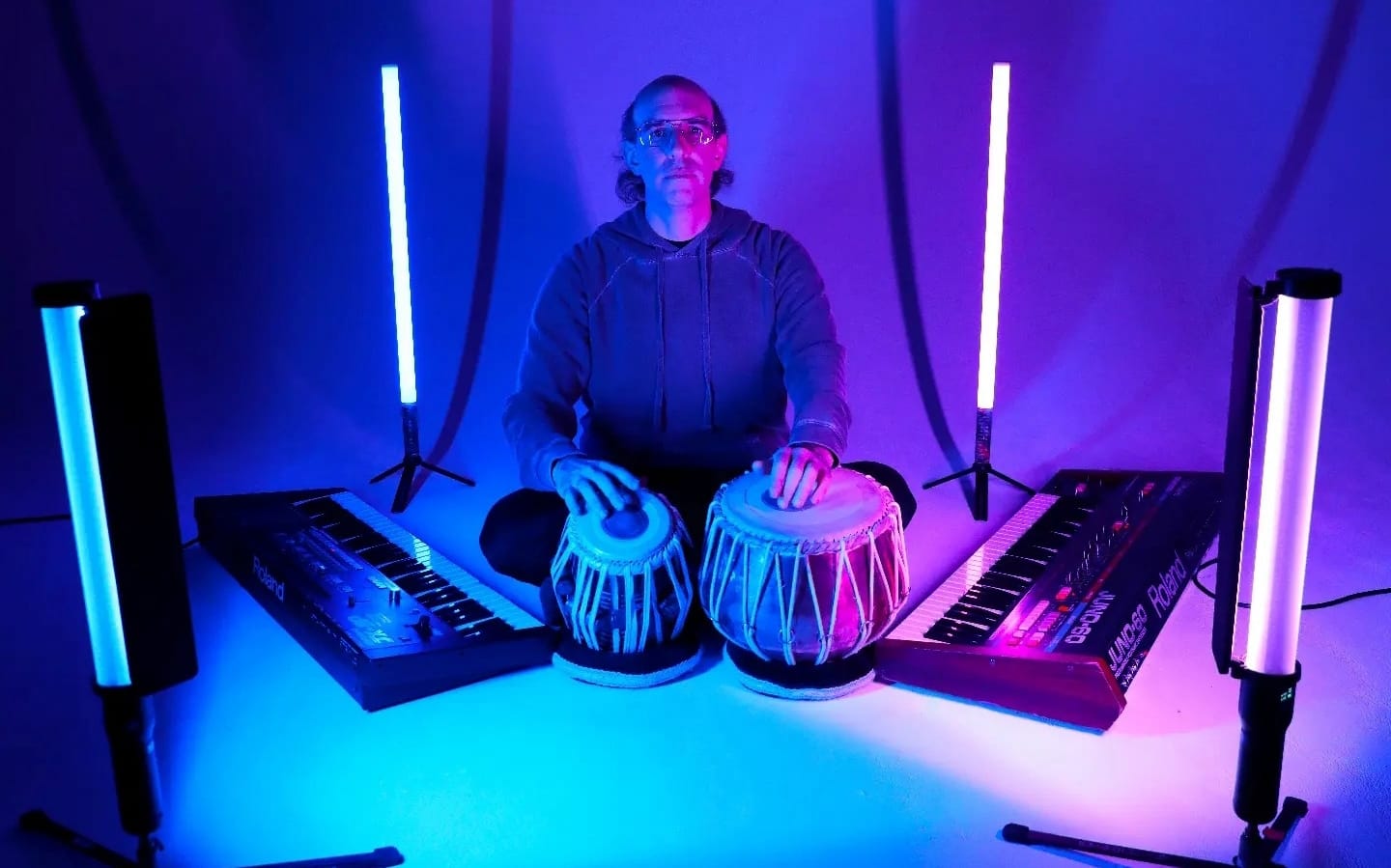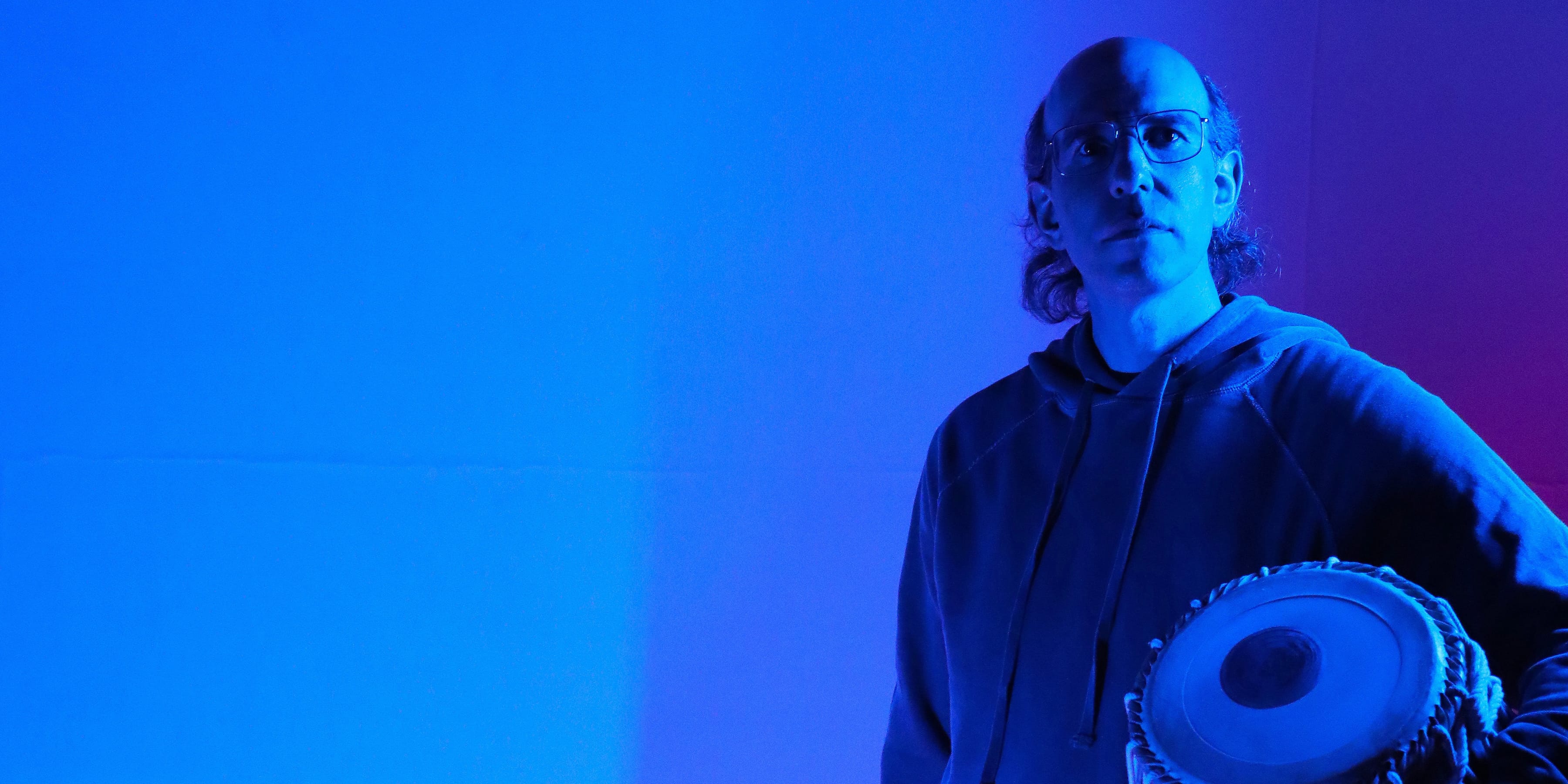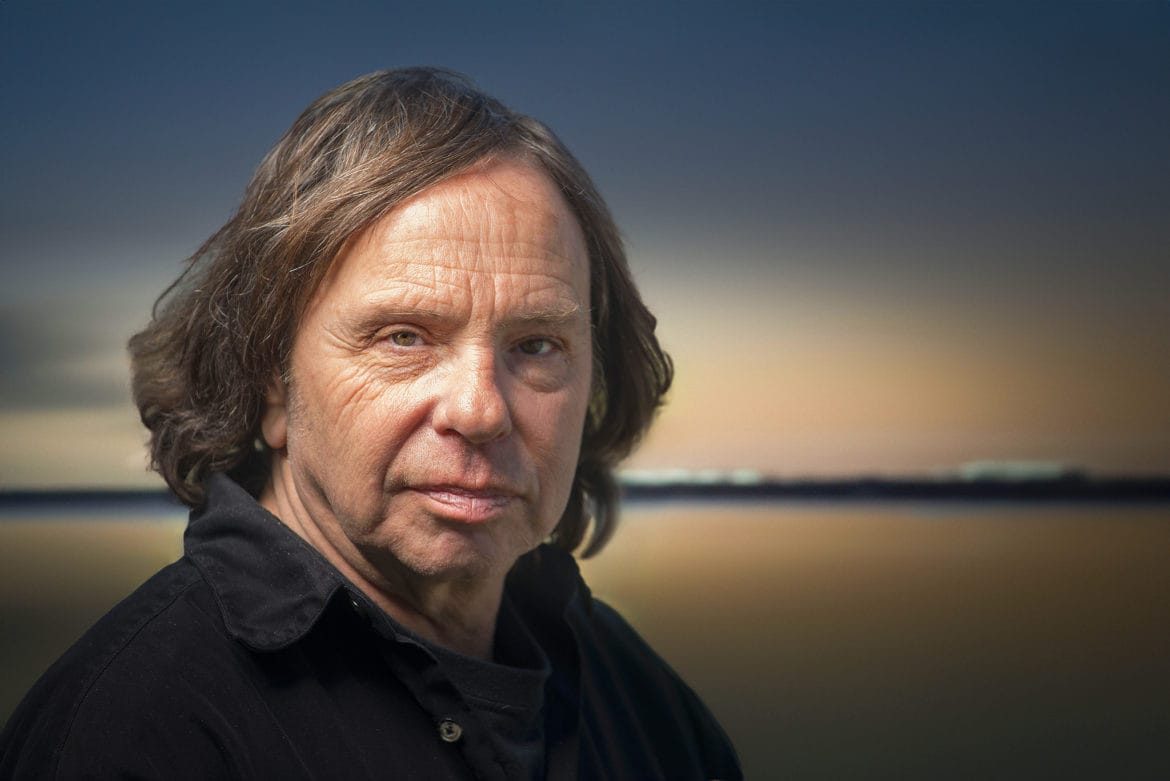• Canadian tabla player known for blending Indian classical music with electronics.
• Recognized for his efforts to promote Indian classical music in Canada through performances, lectures, and workshops.
• Records and performs electronic music under the alias Temporal Waves.
• Website | Instagram | YouTube | Website
"Wow, what is this amazing sound?" So began Shawn Mativetsky's ongoing dedication to the art and tradition of the tabla. Thirty years later, Shawn is an accomplished master at the tabla—though "always learning"—and teaches the instrument alongside other percussion at McGill University's Schulich School of Music in Montreal. He has recorded and released several albums and EPs under Shawn Mativetsky and Temporal Waves. Temporal Waves is the project name and the title of his latest album, a project that mixes the tabla concepts found in Indian classical music with ambient electronica.
I should probably tell you a little about the tabla. The instrument, central to North Indian music, consists of two distinct components: the daya (right drum) and baya (left drum). The daya produces the higher-pitched sounds and is tuned to specific notes, while the larger baya generates deeper bass tones. Musicians strike the drum heads with their fingers and palms, utilizing a complex system of rhythmic syllables called bols that create intricate patterns. It's especially recognizable; chances are you're hearing a tabla playing inside your head right now.
Shawn joined Lawrence Peryer on the Spotlight On podcast to talk about the technique that makes the tabla such a unique instrument, how he found and studied under a traditional guru, why sitting may be the most challenging element of tabla playing, and the inspiration of synthetic retro-culture on Temporal Waves. The conversation has been edited for space and clarity, and you can listen to the entire interview in the podcast player below.
Lawrence Peryer: For the benefit of our readers, Shawn is sitting in front of an amazing collection of instruments. Are all of the instruments behind you tabla?
Shawn Mativetsky: Yeah, and there are two more shelves that you don't see.
Lawrence: Wow, so what is the significance of that? Is it a tuning thing, or could you talk about it?
Shawn: So, depending on the piece's key, you need a different pitch, and the tabla is made for a specific note. You can modify it a bit, and you can go down maybe a tone or so, like one note. And it'll still sound OK. But it doesn't sound good if you go outside the range.
We usually start with a C pitch and then maybe, "Oh, I should get a D," and then, "Oh, it might be nice to have an A-flat," and then it's sometimes handy to have two of the same pitch, in case something happens. You need to have backups, right? And so, over the years, things accumulate a bit.
Lawrence: Are the tablas tuned to the Western scale, or are they microtones?
Shawn: In the traditional context, you tune to whatever the other musician's instrument sounds like. So if I'm accompanying a sitar, some sitars will tune D on an A440 basis, like a regular D. Some will use 432 or some other tuning, and then I tune to them. Musicians doing more cross-cultural collaborations will tend to tune on the regular 440.
Also, many musicians now use apps for the Tanpura drones you hear in performances. When you're using the app, it tends to be in 440. You can move it, of course, but most musicians stick to Western pitches for simplicity. Otherwise, within the scale of a raga, it's natural tuning.
Lawrence: I wanted to ask you a little bit about the development and journey of a young percussionist. How did you end up where you are now?
Shawn: I started with drums at seven. I played in the concert band in high school, so I picked up some Western classical percussion. Then, when I was around seventeen, I heard tabla for the first time and was blown away immediately—"Wow, what is this amazing sound?" It was some fusion recording. I looked at the CD liner notes and went through all the instruments, and I knew what they all were. But there was something called "tabla" that I didn't know. So, just by the process of elimination, that cool sound I heard must be tabla.
I bought a tabla set, and I'm like, "I'll be able to figure this out. It's no problem." I sat down on the floor with my brother, hitting the drums in different ways. Nothing sounded like what we heard in the recording—not even close. Then I understood I had to find a teacher.
I eventually went to Toronto to study with Bob Becker, a well-known Western classical percussionist who also achieved a very high level on tabla. He said from the beginning, "I'll teach you, but you should see my guru as soon as you can." After studying with Bob for five years, I finally had the chance to meet his guru, Pandit Sharda Sahai, who became my guru. I studied with him until he passed away at the end of 2011.
The music styles and contexts vary, but the tabla is my instrument. My daily life revolves around this instrument. I've been very fortunate to have had an amazing teacher, and through a bit of luck and circumstance, this path came before me. Somehow, I'm able to earn a living as a tabla player.
Lawrence: So, it looks deceptively simple. It's two drum heads and two bowls, yet there's a lifetime of study behind what you do. Could you articulate a little bit about what study means in the context of this drum? How far can you go?
Shawn: I still have to determine that last part. It's infinite. It's not an instrument you can learn from books or YouTube videos. It's really when you become a disciple of a guru, which is like becoming an apprentice of a master. You enter into a long-term commitment to each other—the idea is you don't change teachers. That's your teacher for life. You see your teacher as much as possible, as often as possible, and for as long as possible.
I would see my guru three times a year, for three weeks to a month. Every day we see each other. No matter how early I went, he was already practicing in the morning. I would sit down and try to keep up with him for two or three hours. This was just his morning warm-up routine. Then maybe he would give me a lesson, and we'd have lunch together. After lunch, if I didn't have a lesson, he would say, "Go practice."
It's about learning the music and much more than that—you learn about all aspects of life. If my guru had a concert, as students, we carried the instrument for him. At the same time, we hang out backstage, watch his pre-concert routine, see the interactions with the sound technician, and all the behind-the-scenes stuff. It's like a full education, not just how to play the instrument, but all that goes around the profession. It's a very deep relationship, like becoming a family member.

Lawrence: Did you encounter cultural resistance? Is the community of Hindustani musicians excited about having a Western student or a Western face amongst them? Or was there an element of appropriation, bad vibes, or anything else?
Shawn: It's funny because people were so welcoming in my guru's family and community, whether in London or India in Banaras. They think, "Wow, someone outside our culture is so interested and serious about the music. Look at all the time he's putting in. Look at all these trips he's making;" It was seen as a very positive thing. Sometimes, I hear comments from people within the South Asian community, like, "Our kids aren't interested in this music, like the classical music; it's not popular music. But look, you're not even from this culture and devoting your entire life to it."
Questions of cultural appropriation and skepticism arise more outside of India. And I think it's normal because some people don't follow tradition, maybe haven't immersed themselves enough, and they're making missteps without knowing they're making missteps. So I can understand the need to prove myself.
For example, in the tradition, you need your guru or teacher's permission before taking professional engagements or performing publicly. You also need permission before you begin teaching. But many people don't know that. I've seen someone who's gone to India for six months and then returned and started teaching.
Usually, when people ask me how long it takes to be able to play tabla, I say, "After ten years, you become a beginner." For how long I've been playing tabla—it's around thirty years now—I still feel like I don't know much. I have many more years of practice and absorbing the material that my guru taught me to be able to do justice to it.
It's a never-ending thing; you're always learning something new without necessarily learning new compositions. It's not about amassing repertoire but instead going deep with what you have. Some are fixed compositions, and you play them just as they are, and others are seeds for improvisation. There's always some discovery, something new, or you go to a concert, and someone plays a composition in a new way.
Lawrence: Given the deceptive simplicity of the instrument, what's the initial hurdle to creating? What's the first lesson that you have to learn?
Shawn: For many people, it's just to be able to sit for a long time. There are stories of gurus who would make their students just sit for two or three hours before they would teach them anything. We need to practice for an hour a day at first. Two hours a day, three hours a day, later, when it becomes more serious, we're practicing six hours a day, eight hours a day, this kind of thing. That is a hurdle for some people, but just making a nice sound takes time. We practiced a lot of phrases—we repeated short phrases, and then we increased the speed. It requires practicing repetitive focus. When you feel the music, you don't feel it like a chore, right? The enjoyment is there. Your enjoyment increases as you hear the sound improving because you're getting that sound you've longed for.
The other challenge is the speed, which also takes time. Like learning anything, I think you have a lot of quick improvement at first. Then, as you get better, the progress slows down. You must do these marathon practice sessions to inch up faster or clearer. You do some of this practice in groups, too, but you must do any nuanced practice alone.

Lawrence: Many music artists I talk with use the word research for their work. Do you think of your practice or your work as research?
Shawn: For the album Temporal Waves, I had to go through a process of exploration and learning, working with analog synthesizers and creating sounds. That's research. Research is not just reading books and things like that; it's information and experimentation. Reading about different kinds of interpretation—that's research. We listen to performances to inform ours. That's research.
Lawrence: When you began the work for Temporal Waves, did you have a concept in mind, or what journey did you go on in making this record?
Shawn: Research! [laughter] I wanted to return to something I had been doing before, but from a different angle. I was doing electronic music as a serious hobby in the nineties. It was not part of my professional music-making so I set that aside for many years.
Another aspect that came out during the pandemic was a sense of comfort and nostalgia. There's a comfort to nostalgia when thinking about youth. So, I was reminiscing about electronics and growing up with Atari and Nintendo. At the same time, shows like Stranger Things brought back these retro '80s and '90s vibes. I decided to revisit electronics but saw something I hadn't seen before. Now I can integrate tabla with this.
I saw how the tabla could connect with electronics because it has a warm, organic sound. Now, I didn't necessarily have the concept. I didn't know that the music would be a kind of "ambient experimental synth-wave;" I'm not sure what label to put on it. It doesn't sound like Indian music on the surface, other than that the tabla is there. I started processing the tabla through guitar pedals and seeing what kind of different things I could come up with. I got some synthesizers and started to play with them. It became clear what was going on from piece to piece. This was more improvisatory, more free.
Aside from the musical inspiration, this project's main goal was to bring tabla to new audiences. I've been hanging out online with some people in the synth-wave scene, and many are hearing tabla for the first time, which is great. So, even though tabla is heard in a completely non-traditional way in this context if I can open a gateway into tabla or Indian classical music for listeners, that would make me very happy.
Shawn Mativetsky's self-titled album as Temporal Waves is out now, available from Bandcamp, Qobuz, and your streaming platform of choice.






Comments